Xu Cao
EAROL: Environmental Augmented Perception-Aware Planning and Robust Odometry via Downward-Mounted Tilted LiDAR
Aug 20, 2025Abstract:To address the challenges of localization drift and perception-planning coupling in unmanned aerial vehicles (UAVs) operating in open-top scenarios (e.g., collapsed buildings, roofless mazes), this paper proposes EAROL, a novel framework with a downward-mounted tilted LiDAR configuration (20{\deg} inclination), integrating a LiDAR-Inertial Odometry (LIO) system and a hierarchical trajectory-yaw optimization algorithm. The hardware innovation enables constraint enhancement via dense ground point cloud acquisition and forward environmental awareness for dynamic obstacle detection. A tightly-coupled LIO system, empowered by an Iterative Error-State Kalman Filter (IESKF) with dynamic motion compensation, achieves high level 6-DoF localization accuracy in feature-sparse environments. The planner, augmented by environment, balancing environmental exploration, target tracking precision, and energy efficiency. Physical experiments demonstrate 81% tracking error reduction, 22% improvement in perceptual coverage, and near-zero vertical drift across indoor maze and 60-meter-scale outdoor scenarios. This work proposes a hardware-algorithm co-design paradigm, offering a robust solution for UAV autonomy in post-disaster search and rescue missions. We will release our software and hardware as an open-source package for the community. Video: https://youtu.be/7av2ueLSiYw.
Incorporating Flexible Image Conditioning into Text-to-Video Diffusion Models without Training
May 27, 2025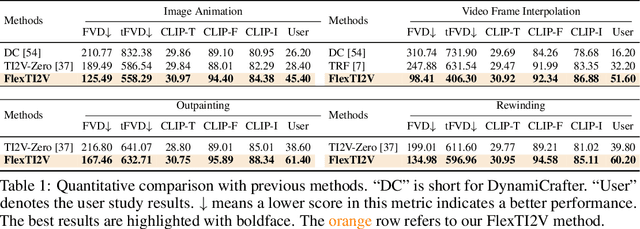

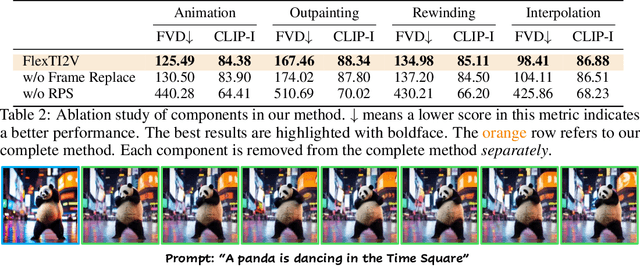
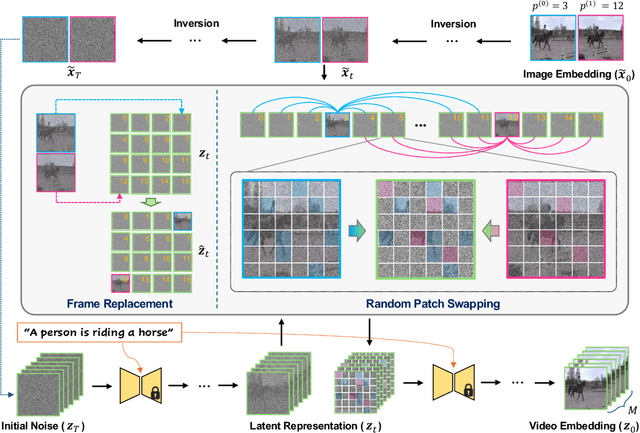
Abstract:Text-image-to-video (TI2V) generation is a critical problem for controllable video generation using both semantic and visual conditions. Most existing methods typically add visual conditions to text-to-video (T2V) foundation models by finetuning, which is costly in resources and only limited to a few predefined conditioning settings. To tackle this issue, we introduce a unified formulation for TI2V generation with flexible visual conditioning. Furthermore, we propose an innovative training-free approach, dubbed FlexTI2V, that can condition T2V foundation models on an arbitrary amount of images at arbitrary positions. Specifically, we firstly invert the condition images to noisy representation in a latent space. Then, in the denoising process of T2V models, our method uses a novel random patch swapping strategy to incorporate visual features into video representations through local image patches. To balance creativity and fidelity, we use a dynamic control mechanism to adjust the strength of visual conditioning to each video frame. Extensive experiments validate that our method surpasses previous training-free image conditioning methods by a notable margin. We also show more insights of our method by detailed ablation study and analysis.
Sage Deer: A Super-Aligned Driving Generalist Is Your Copilot
May 15, 2025Abstract:The intelligent driving cockpit, an important part of intelligent driving, needs to match different users' comfort, interaction, and safety needs. This paper aims to build a Super-Aligned and GEneralist DRiving agent, SAGE DeeR. Sage Deer achieves three highlights: (1) Super alignment: It achieves different reactions according to different people's preferences and biases. (2) Generalist: It can understand the multi-view and multi-mode inputs to reason the user's physiological indicators, facial emotions, hand movements, body movements, driving scenarios, and behavioral decisions. (3) Self-Eliciting: It can elicit implicit thought chains in the language space to further increase generalist and super-aligned abilities. Besides, we collected multiple data sets and built a large-scale benchmark. This benchmark measures the deer's perceptual decision-making ability and the super alignment's accuracy.
PMNI: Pose-free Multi-view Normal Integration for Reflective and Textureless Surface Reconstruction
Apr 14, 2025Abstract:Reflective and textureless surfaces remain a challenge in multi-view 3D reconstruction. Both camera pose calibration and shape reconstruction often fail due to insufficient or unreliable cross-view visual features. To address these issues, we present PMNI (Pose-free Multi-view Normal Integration), a neural surface reconstruction method that incorporates rich geometric information by leveraging surface normal maps instead of RGB images. By enforcing geometric constraints from surface normals and multi-view shape consistency within a neural signed distance function (SDF) optimization framework, PMNI simultaneously recovers accurate camera poses and high-fidelity surface geometry. Experimental results on synthetic and real-world datasets show that our method achieves state-of-the-art performance in the reconstruction of reflective surfaces, even without reliable initial camera poses.
SocialGesture: Delving into Multi-person Gesture Understanding
Apr 03, 2025Abstract:Previous research in human gesture recognition has largely overlooked multi-person interactions, which are crucial for understanding the social context of naturally occurring gestures. This limitation in existing datasets presents a significant challenge in aligning human gestures with other modalities like language and speech. To address this issue, we introduce SocialGesture, the first large-scale dataset specifically designed for multi-person gesture analysis. SocialGesture features a diverse range of natural scenarios and supports multiple gesture analysis tasks, including video-based recognition and temporal localization, providing a valuable resource for advancing the study of gesture during complex social interactions. Furthermore, we propose a novel visual question answering (VQA) task to benchmark vision language models'(VLMs) performance on social gesture understanding. Our findings highlight several limitations of current gesture recognition models, offering insights into future directions for improvement in this field. SocialGesture is available at huggingface.co/datasets/IrohXu/SocialGesture.
STAMICS: Splat, Track And Map with Integrated Consistency and Semantics for Dense RGB-D SLAM
Mar 27, 2025Abstract:Simultaneous Localization and Mapping (SLAM) is a critical task in robotics, enabling systems to autonomously navigate and understand complex environments. Current SLAM approaches predominantly rely on geometric cues for mapping and localization, but they often fail to ensure semantic consistency, particularly in dynamic or densely populated scenes. To address this limitation, we introduce STAMICS, a novel method that integrates semantic information with 3D Gaussian representations to enhance both localization and mapping accuracy. STAMICS consists of three key components: a 3D Gaussian-based scene representation for high-fidelity reconstruction, a graph-based clustering technique that enforces temporal semantic consistency, and an open-vocabulary system that allows for the classification of unseen objects. Extensive experiments show that STAMICS significantly improves camera pose estimation and map quality, outperforming state-of-the-art methods while reducing reconstruction errors. Code will be public available.
A Survey of Embodied AI in Healthcare: Techniques, Applications, and Opportunities
Jan 13, 2025



Abstract:Healthcare systems worldwide face persistent challenges in efficiency, accessibility, and personalization. Powered by modern AI technologies such as multimodal large language models and world models, Embodied AI (EmAI) represents a transformative frontier, offering enhanced autonomy and the ability to interact with the physical world to address these challenges. As an interdisciplinary and rapidly evolving research domain, "EmAI in healthcare" spans diverse fields such as algorithms, robotics, and biomedicine. This complexity underscores the importance of timely reviews and analyses to track advancements, address challenges, and foster cross-disciplinary collaboration. In this paper, we provide a comprehensive overview of the "brain" of EmAI for healthcare, wherein we introduce foundational AI algorithms for perception, actuation, planning, and memory, and focus on presenting the healthcare applications spanning clinical interventions, daily care & companionship, infrastructure support, and biomedical research. Despite its promise, the development of EmAI for healthcare is hindered by critical challenges such as safety concerns, gaps between simulation platforms and real-world applications, the absence of standardized benchmarks, and uneven progress across interdisciplinary domains. We discuss the technical barriers and explore ethical considerations, offering a forward-looking perspective on the future of EmAI in healthcare. A hierarchical framework of intelligent levels for EmAI systems is also introduced to guide further development. By providing systematic insights, this work aims to inspire innovation and practical applications, paving the way for a new era of intelligent, patient-centered healthcare.
Medical Video Generation for Disease Progression Simulation
Nov 18, 2024Abstract:Modeling disease progression is crucial for improving the quality and efficacy of clinical diagnosis and prognosis, but it is often hindered by a lack of longitudinal medical image monitoring for individual patients. To address this challenge, we propose the first Medical Video Generation (MVG) framework that enables controlled manipulation of disease-related image and video features, allowing precise, realistic, and personalized simulations of disease progression. Our approach begins by leveraging large language models (LLMs) to recaption prompt for disease trajectory. Next, a controllable multi-round diffusion model simulates the disease progression state for each patient, creating realistic intermediate disease state sequence. Finally, a diffusion-based video transition generation model interpolates disease progression between these states. We validate our framework across three medical imaging domains: chest X-ray, fundus photography, and skin image. Our results demonstrate that MVG significantly outperforms baseline models in generating coherent and clinically plausible disease trajectories. Two user studies by veteran physicians, provide further validation and insights into the clinical utility of the generated sequences. MVG has the potential to assist healthcare providers in modeling disease trajectories, interpolating missing medical image data, and enhancing medical education through realistic, dynamic visualizations of disease progression.
On-Board Vision-Language Models for Personalized Autonomous Vehicle Motion Control: System Design and Real-World Validation
Nov 17, 2024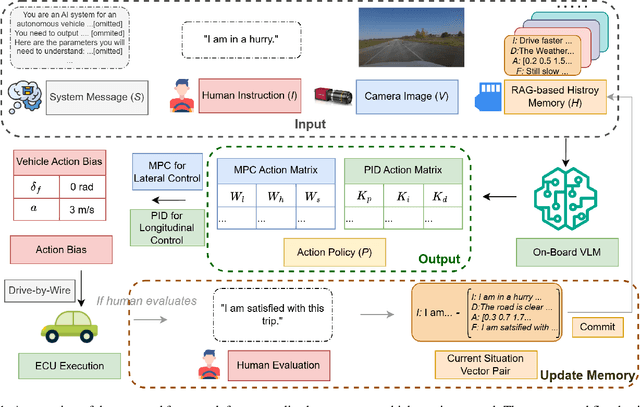
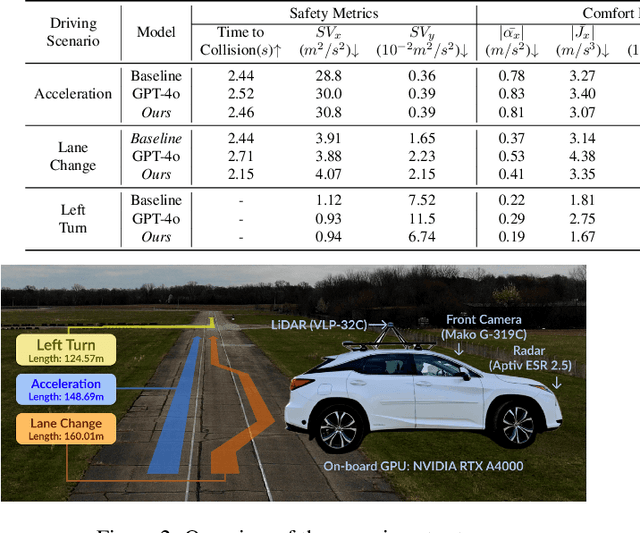

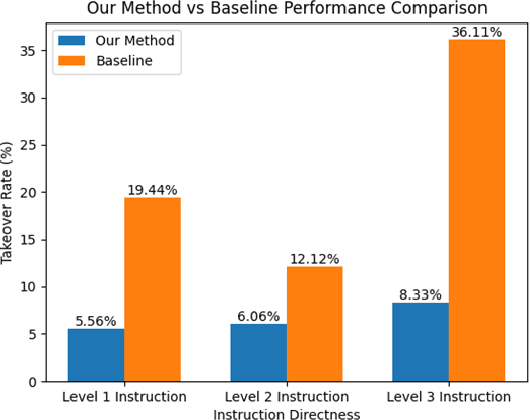
Abstract:Personalized driving refers to an autonomous vehicle's ability to adapt its driving behavior or control strategies to match individual users' preferences and driving styles while maintaining safety and comfort standards. However, existing works either fail to capture every individual preference precisely or become computationally inefficient as the user base expands. Vision-Language Models (VLMs) offer promising solutions to this front through their natural language understanding and scene reasoning capabilities. In this work, we propose a lightweight yet effective on-board VLM framework that provides low-latency personalized driving performance while maintaining strong reasoning capabilities. Our solution incorporates a Retrieval-Augmented Generation (RAG)-based memory module that enables continuous learning of individual driving preferences through human feedback. Through comprehensive real-world vehicle deployment and experiments, our system has demonstrated the ability to provide safe, comfortable, and personalized driving experiences across various scenarios and significantly reduce takeover rates by up to 76.9%. To the best of our knowledge, this work represents the first end-to-end VLM-based motion control system in real-world autonomous vehicles.
AnyECG: Foundational Models for Electrocardiogram Analysis
Nov 17, 2024



Abstract:Electrocardiogram (ECG), a non-invasive and affordable tool for cardiac monitoring, is highly sensitive in detecting acute heart attacks. However, due to the lengthy nature of ECG recordings, numerous machine learning methods have been developed for automated heart disease detection to reduce human workload. Despite these efforts, performance remains suboptimal. A key obstacle is the inherent complexity of ECG data, which includes heterogeneity (e.g., varying sampling rates), high levels of noise, demographic-related pattern shifts, and intricate rhythm-event associations. To overcome these challenges, this paper introduces AnyECG, a foundational model designed to extract robust representations from any real-world ECG data. Specifically, a tailored ECG Tokenizer encodes each fixed-duration ECG fragment into a token and, guided by proxy tasks, converts noisy, continuous ECG features into discrete, compact, and clinically meaningful local rhythm codes. These codes encapsulate basic morphological, frequency, and demographic information (e.g., sex), effectively mitigating signal noise. We further pre-train the AnyECG to learn rhythmic pattern associations across ECG tokens, enabling the capture of cardiac event semantics. By being jointly pre-trained on diverse ECG data sources, AnyECG is capable of generalizing across a wide range of downstream tasks where ECG signals are recorded from various devices and scenarios. Experimental results in anomaly detection, arrhythmia detection, corrupted lead generation, and ultra-long ECG signal analysis demonstrate that AnyECG learns common ECG knowledge from data and significantly outperforms cutting-edge methods in each respective task.
 Add to Chrome
Add to Chrome Add to Firefox
Add to Firefox Add to Edge
Add to Edge